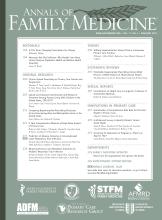Abstract
PURPOSE The Canadian Primary Care Sentinel Surveillance Network (CPCSSN) is Canada’s first national chronic disease surveillance system based on electronic health record (EHR) data. The purpose of this study was to develop and validate case definitions and case-finding algorithms used to identify 8 common chronic conditions in primary care: chronic obstructive pulmonary disease (COPD), dementia, depression, diabetes, hypertension, osteoarthritis, parkinsonism, and epilepsy.
METHODS Using a cross-sectional data validation study design, regional and local CPCSSN networks from British Columbia, Alberta (2), Ontario, Nova Scotia, and Newfoundland participated in validating EHR case-finding algorithms. A random sample of EHR charts were reviewed, oversampling for patients older than 60 years and for those with epilepsy or parkinsonism. Charts were reviewed by trained research assistants and residents who were blinded to the algorithmic diagnosis. Sensitivity, specificity, and positive and negative predictive values (PPVs, NPVs) were calculated.
RESULTS We obtained data from 1,920 charts from 4 different EHR systems (Wolf, Med Access, Nightingale, and PS Suite). For the total sample, sensitivity ranged from 78% (osteoarthritis) to more than 95% (diabetes, epilepsy, and parkinsonism); specificity was greater than 94% for all diseases; PPV ranged from 72% (dementia) to 93% (hypertension); NPV ranged from 86% (hypertension) to greater than 99% (diabetes, dementia, epilepsy, and parkinsonism).
CONCLUSIONS The CPCSSN diagnostic algorithms showed excellent sensitivity and specificity for hypertension, diabetes, epilepsy, and parkinsonism and acceptable values for the other conditions. CPCSSN data are appropriate for use in public health surveillance, primary care, and health services research, as well as to inform policy for these diseases.
- primary health care
- chronic disease
- validation studies
- electronic health records
- sensitivity and specificity
- Received for publication September 17, 2013.
- Revision received January 30, 2014.
- Accepted for publication February 22, 2014.
- © 2014 Annals of Family Medicine, Inc.







